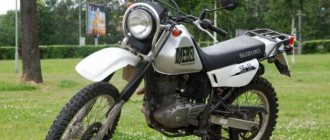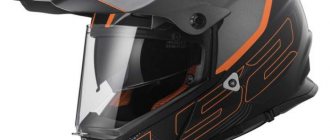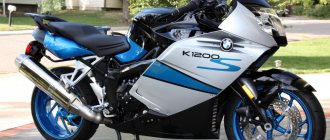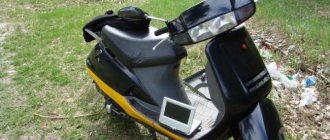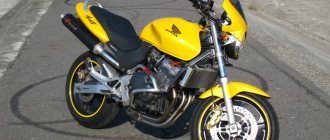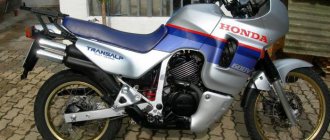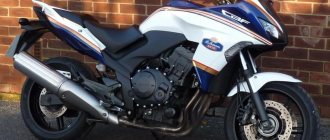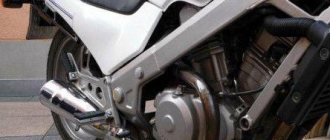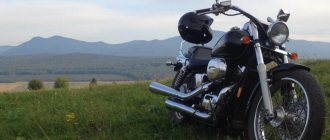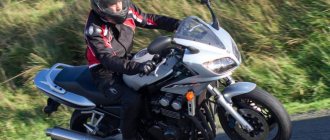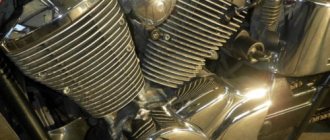The Japanese-made Honda Saber motorcycle is the leading representative of the Shadow line. He has a lot in common with the rest of the Shadows. Nevertheless, the unit is noticeably different from them, which is what served to separate it into a separate model. Essentially, the two-wheeler is an original and stylish cruiser that emulates classic American styling. Exotic and extreme innovations are not used in the design; the basis of the bike is the good old classic. Let's look at its features, characteristics and capabilities.
brief information
Most Japanese motorcycles are characterized as stable vehicles without frills or flaws. This characteristic also applies to the Honda Saber. Everything about the motorcycle is thought out to the smallest detail. The bike has several modifications, aimed primarily at the American market. There are models whose engine imitates the legendary Harley Davidson engine. Its connecting rods are placed on one rack, and the sound of the running “engine” has become rougher.
Another feature of the power unit is the increase in “vocality” at low speeds and its leveling at maximum load. This is due to the fact that the more similar a unit is to a Harley, the better it sells.
In Russia, this model was also not ignored. The S-2 modification can be purchased not only secondhand, but also through official dealers. An important factor is that the device is designed for various types of road surfaces without significantly changing the comfort of movement.
For whom
The version has the following features:
- wheel rims have a special shape;
- the engine is the same as that of the Spirit modification;
- high power.
The motorcycle is not very suitable for beginners. However, in the hands of a professional, the Honda VT 1100 Shadow Saber will become a real ship, smoothly and majestically plowing the road.
Power plant and transmission unit
The engine of the Honda Shadow Saber motorcycle can be described in just two words – convenience and reliability. The power unit does not have balance shafts, while ensuring minimal vibration of the unit. For starting, a constant vacuum carburetor is used, which is combined with an accelerator pump. This provides the engine with excellent dynamic performance. By changing the oil and filter elements in a timely manner, you can enjoy the operation of the engine for decades without any repairs. Prevention, care and proper operation are the key to successful use of the model in question.
The transmission unit amazes with its practicality and durability. Literally without wear, it can last at least one hundred thousand kilometers. Of particular note is the cardan transmission, which is distinguished by its strength and resistance to deformation of the connecting elements in comparison with direct competitors of the same manufacturer or foreign analogues.
Device
The Honda Saber frame has a classic twin-frame design with decent performance. It is positioned as a stable operating element, regardless of the modes used when operating the motorcycle. This part is most often subject to styling and all sorts of modifications; fortunately, there are more than enough materials and devices for this.
At the rear, the suspension is adjusted by preloading the springs. The front fork responds well even during emergency braking. In general, the suspension unit can be described as comfortable and energy-intensive. It is not prone to breakdowns and makes it possible to have good control of the vehicle on different surfaces.
The brakes do their job perfectly and do not require any tuning. The rear brake control takes some getting used to and may seem harsh at first. It is worth noting that the Honda Saber motorcycle is very comfortable, so much so that some modifications were produced with a focus on reducing comfort.
Chassis and brakes
The steel frame has a classic look for such a machine. The VT 1100 Shadow Saber features a stunning black paint job that highlights the bike's understated power. The wheels are alloy, which goes well with the modern look of the model. The steering wheel has standard dimensions.
The pendulum suspension at the rear is equipped with two shock absorbers. The stroke is 100 mm. At the front, there is a telescopic fork with dimensions of 41 mm and a stroke of 150 mm. The rear brake is a single-piston caliper and a 276 mm disc. There is also one disc at the front, but its size is 316 mm, and the caliper is two-piston.
Modifications
It makes no sense to list all the models in this line - there are so many of them. Let's focus on the modification of Honda Saber UA2, which is aimed at the market of the United States of America. It differs in that it has a cylinder head with three valves, a more aggressive body kit, and a special style. The unit is equipped with a liquid-cooled V-shaped engine with a volume of 1099 cubic centimeters and spark plugs. The predecessor of this model, called the Honda Shadow 1100 Saber, is one of the most popular choppers on the world market.
A well-thought-out weight distribution allows you to balance the decent weight of the motorcycle and its traction characteristics. The seat height has been adjusted so that most riders can reach the ground with their feet without leaving the saddle. The ergonomics of the device and the laconic, informative instrument panel are another plus for the bike in question. A comfortable steering wheel and well-placed passenger footrests organically fit into the overall exterior of the cruiser.
Honda Saber (Inspire) UA4-UA5 (description and characteristics)
Similar articles
- Honda J-series engines (J25A, J30A, J35A, J37A). Characteristics, applicability, reliability,…
- Suspension Parts: NHK Product Seminar
- Spring chassis maintenance. What you should pay attention to.
Honda Inspire is an absolute masterpiece of Honda. The history of this model begins back in 1989, when the company tried to “attack” the most expensive part of the business segment. When creating the car, engineers focused on the most prestigious and high-quality brands that were present on the market at that moment. Honda has never skimped on development, this is its “trademark rule,” and therefore, having decided to “invade” the market of expensive business cars, it set itself the task of producing products better than those of its competitors.
If you write a story about the history of this model from the very beginning, then it is easier to create a separate website for this. A lot of different interesting solutions and approaches were used in this car. Therefore, we will limit ourselves to reviewing only one version. In this article we will talk about the fourth, most widespread generation of these cars in Russia, which also brings together many interesting technical solutions. We will talk about the Honda Inspire and Honda Saber in the UA4 and UA5 body.
The “mass availability” of these cars is not due to any unique characteristics of this particular “body,” but rather to the economic situation in Russia in the early and mid-2000s. In those days, there were no restrictions on the import of cars from Japan, and therefore “Inspires” and “Sabers” in the back of UA4 and UA5 poured into the Russian market, filling the segment of expensive cars. Of course, these cars began their victorious march from the Far East, where the existence of “right-hand drive” was treated with respect and seriousness, and “left-hand drive” BMWs, Mercedes and other “Germans” were unreasonably expensive.
Against the backdrop of the “Varangians”, the “Japanese” looked very attractive for several reasons. Firstly, this is, of course, the wonderful “Honda” J-series engine, which had no problems and produced excellent performance in terms of power and torque. The modest “Japanese” 2.5 liters produced a respectable 200 hp, which were unattainable at that moment by many thoroughbred “Germans”. And the J32 engine in the Type S configuration produced an incredible 260 hp, giving fantastic acceleration for such a rather large “frigate”.
Secondly, it is, of course, comfort. In general, Honda has a very unique concept of “comfort”. On regular Honda models, “comfort” is considered to be the presence of a seat that holds the driver’s butt well, and a minimal amount of sound insulation, just so that you don’t have to shout over the sound of the engine. The Saber and Inspire had an exceptional level of comfort for Honda. And the point here is not so much in the Japanese, but in the American approach. The most interesting fact about this model is that the car was assembled in America. Yes, it was originally intended for the US and Canadian markets, and therefore the approach to convenience was “American”. Everything had to be as customer-oriented, quiet, and durable as possible. The cars were produced in America and then re-exported to Japan, and therefore were in some ways even “luxurious” by “Japanese” standards. Of course, there were competitors, for example the Toyota Crown, but in comparison with the same imposing Crown, the Inspire/Saber retained its lean and sporty character. A kind of “Doberman” from Honda - beautiful, but sporty, fast and dangerous (in the good sense of the word).
Thirdly, the car was and remains fantastically reliable. Each of its elements was thought out by American Honda engineers for Americans who do not like and do not know how to look after cars. Thanks to good roads and a fairly mild climate, Americans very rarely call for maintenance, preferring to drive their car “until the last minute.” And, despite this, the cars did not break down, “forgiving” the owners for forgetfulness and laziness. The weak points, after almost twenty (!!!) years of operation, are the power steering hoses, which crack at the first frost, and the automatic transmission, which requires more frequent oil changes. And this despite the fact that in our memory no one has ever tried to replace all the hoses with new ones, replacing them with “contract” ones from an auto-disassembly shop (that is, also fifteen years old). The situation with automatic transmission is generally interesting. Almost all drivers “squeeze” the maximum out of the engine, starting from every traffic light almost from the cutoff, and then they wonder why problems begin with the gearbox after fifteen years of “fun starts”...
This is how this car turned out: reliable, powerful and very comfortable for a Honda. Among fans, it is considered one of the most “indestructible” vehicles and symbolizes the best traditions of the Honda company.
Technical characteristics of Honda Inspire / Honda Saber UA4 - UA5:
Years of production: 1998-2003.
Car length: 4840 mm (pre-restyle), 4860 mm (restyle).
Car width: 1785 mm (pre-style), 1795 mm (restyle).
Vehicle height: 1420 mm.
Ground clearance: 155 mm.
Engine:
J25A - power: 200 hp / 6200 rpm, torque: 240 Nm / 4700 rpm.
J32A - power: 225 hp/5500 rpm, torque: 294 Nm/4500 rpm.
J32A Type S - power: 260 hp/6100 rpm, torque: 314/3500 rpm.
Front, transverse, V6.
Suspension: multi-link, classic Honda type.
Drive: front.
Gearbox: automatic, classic type.
If you find an error, please select a piece of text and press Ctrl+Enter.
More interesting articles
Honda VT 1100 Shadow Saber: technical specifications
Below is a list of tactical and technical indicators of the motorcycle in question:
- power unit – Honda VT 1100 Saber – 2007;
- engine volume – 1099 cc. cm;
- cylinders (diameter and stroke) - 87.5/91.4 millimeters;
- maximum power - forty-nine kilowatts;
- ignition type – starter;
- speed – 5500 rotations per minute;
- power - about sixty-six horsepower;
- fuel tank capacity – sixteen liters;
- weight – two hundred and sixty kilograms;
- tires – 170/80-15;
- brakes – disc type “Single-315 mm”;
- year of production – from 2007 to 2009.
In addition, it is worth noting the external design of the motorcycle, which resembles a small copy of the American Harley Davidson, since it also has some chrome parts and a unique engine layout.
Owner reviews
Judging by user reviews, the Honda Saber motorcycle is truly a benchmark in its class. The owners include the advantages of the unit as its beautiful exterior, practicality and durability of the engine, high mileage, stability, comfortable landing, and safety.
Among the disadvantages, consumers note hard standard seats and the high cost of original spare parts. As for the “seats”, which lead to the fact that the back becomes wooden after a long trip, no one forbids replacing them. Otherwise, the bike in question is every motorcyclist’s dream.
Test Drive
As a result of the run-in, several important points can be noted:
- The motorcycle suspensions performed well, despite their stiffness.
- The vehicle handles the road perfectly and shows excellent maneuverability.
- We are pleased with the reliable brakes and comfortable seating.
- Fans of exclusive models will appreciate the ability of the engine to change its “melody” after switching from low to high speeds.
- A comfortable steering wheel and information display only contribute to comfortable movement.
The Honda Saber motorcycle is an ideal option for short-term travel around the city and beyond. It is unlikely to be suitable for long walks, but it can rightfully be called one of the best choppers in the line.
In conclusion
Japanese designers have created a truly reliable, stylish and balanced Saber motorcycle. It is lighter than its “brothers” like the VTX-1800, but can compete on equal terms not only with them, but also with cruisers made in the United States and Germany. It is this quality that has made the motorcycle a favorite of many bikers.
The vehicle in question was initially designed as a reliable, durable motorcycle, suitable for riding on various road surfaces. The car is distinguished not only by its original design, but also by its V-shaped engine, which harmoniously fits into the overall concept, reminiscent of the style of the legendary American legend under the sonorous name “Harley Davidson”.
Review of the Honda VT1300C motorcycle (Fury, Saber, Stateline)
Imagine you are a biker, bald or hairy, brutal, with huge biceps and a bunch of tattoos. and for a holiday, birthday or New Year - it doesn’t matter if they give you a vase or a sweater with deer... This has happened at least once.
When buying a factory cruiser, any biker is ready to saw off the ridiculous turn signals and license plate, hide the wiring, install a more stylish saddle and handlebars, not to mention footpegs, handles and other lame accessories.
Honda Fury, or Fura, as I call it, didn’t come to me by chance. At the motorcycle showroom, having gone to say hello to my friends-managers, I walked in and froze. In front of me stood a stunning custom, the correct and laconic lines of which brought me into cultural ecstasy. Steering wheel, speedometer, fork, 21st front wheel, frame, shining chrome engine... Big Dog, Iron Нorse, OCC?.. Nope, Honda!!!
Why didn't you get it by chance? Because I put my favorite motorcycle and equipment up for sale, very cheaply, borrowed money, and blew the brains out of all the motorcyclists I knew, sat all night long on American websites, compared reviews (not always positive), and watched dozens of hours of amateur videos happy owners of this masterpiece on YouTube... And... you won’t believe it, I started going to the gym regularly again!! This bike inspires...
He eats and rushes. 13 liters is enough for me for 230 km. The light shows everything, if anything. 130 is cruising on the highway (I ride without a windshield - it’s not comfortable faster), in the city it handles like any other factory motorcycle. The motor is new, about spare parts, etc. There is no point in writing yet. Consumables are available in any store. The injector is just a zero and you can’t install tuning pipes, you’ll have to plug in a power commander and adjust
The chopper fit is obvious, the color is amazing (all colors are valid) and chrome. A very stylish, informative and expensive speedometer. Pleasant position of arms and legs. The sound is excellent (but I stuck the Cobra pipes in anyway - and the bike came to life!). There is a lot of attention, but the same as for any of my choppers before, but the pleasure from contemplation while sitting with a cigar in a summer cafe is a hundred times greater.
Of the minuses: standard turn signals, license plate mount, grips - in the firebox. The rear seat is not comfortable - just take the next victim from the inspection to the den. A modest tank (but very beautiful). Yes! I had a 1.5-liter Kawasaki Drifter in 1999, so there was a hydraulic clutch, and here it was a cable - it surprised, but did not overshadow. I don’t know whether it’s a disadvantage or an advantage - there’s a lot of plastic: engine chrome, fenders and glove compartments (nothing creaks, but when you touch it you pay attention).
A huge plus is the price. Now there are already 20 of them per author, 15 thousand each, and, I’m afraid, in a year I will begin to meet colleagues on the roads more often. For this money, used two-liter monsters like Suzuki Bolivar, Triumph Rocket or, God forbid, Yamaha Warrior are available, the dreams of ordinary people about which I personally am already tired of..
Of course, with this motorcycle, Honda stopped copying the legendary and beloved Harley (and began to steal someone else's ideas)). And productive!
Two seasons have already passed, and the energy to explain and talk about the motorcycle has not yet run out. I assume that the main charge of the batteries is the incredible fan factor! You experience it at every third traffic light, seeing a hand clenched into a fist, with the thumb pointed up, from cars stopping nearby and, to be honest, sometimes from two-wheeled brothers. Every time I see this gesture of approval, I feel that the choice was made correctly! And how many times did the two of us have to participate in an impromptu photo shoot, which took place during “long” traffic lights at intersections or during short pit stops in numerous cafes of the Mother See. Moreover, the quality of the resulting images and the capabilities of smartphone cameras during night photography were not at all of concern to most photographers - the main thing was that they managed to “take a couple of photos!” I was just moving from point A to point B and didn’t have much time to pose.
And all this happens with a motorcycle, which, although made exclusively according to the canons of construction and perception of large choppers, was made in Japan, a year after the appearance of the founding motorcycle of the “new category” - the Rocker from Harley-Davidson - and six months after the start sales of a competitor from Yamaha. At the same time, it is made not only within the framework of the style, but also with a large number of individual features. However, this is all just an emotional component that you can talk about for hours. And if you ask me about the technical side, first of all I will answer: this is Honda!
Honda Fury has many familiar and time-tested components: a Vtyks gearbox, an engine with a VTX1300 liquid cooling system with new technologies introduced (electronically controlled fuel injection). As well as a maintenance-free driveshaft hidden in the pendulum, rear suspension with the ability to adjust the spring preload. On the one hand, the engine is “strangled,” but on the other, 58 horsepower is more than enough for an urban environment, and there are ways to increase power.
The motorcycle is very easy to control, the ergonomics are “correct”, and the arrangement of many parts and components is thought out as much as possible. It is good to observe the flow in the mirrors; in fact, there is no “dead zone”. Many who “tried on” the motorcycle said that it had a comfortable fit, while the height of the pilots varied from 175 to 195 cm, and the weight varied up to 20 kg. The installed ABS works like clockwork, I had a chance to check it several times this season. This system is required on the Honda Fury, where the front wheel is 21 inches, the tire width is 90, and the fork angle is 38°. The braking system is reliable and efficient, and during the entire period of operation there have never been any problems.
Now a little about technical stereotypes. It's all plastic, you say. Yes, there is a lot of plastic, but outwardly it is chrome, and chrome for motorcycles of this class is “our everything”! Plastic reduced the weight of the motorcycle and reduced the cost of spare parts. And then, how can plastic affect the performance of a motorcycle if it has nothing to do with handling, chassis, or in general, as they say, “does not affect speed”? And I had no plans to ram a brick wall.
Experienced truckers will note that the Honda Fury has a small tank. But this is, first of all, a city motorcycle, intended for movement within the metropolis and its not very distant surroundings. Too many critics simply forget the purpose. Do we expect enduro off-road qualities from a sports motorcycle? Fury copes with its tasks 100%: “cafe racer” and “butterfly handler”. By the way, about women. I know one pretty, fragile girl, Elena, the owner of a similar device, who covered the Kaluga-Sevastopol route in less than one day, alone, with pleasure and at high cruising speed. It is better to ask her about the problem of a small tank, if it can be called a problem at all. Honda motorcycles have always been known for their low fuel consumption, and the Fury can afford a small tank for the sake of aesthetics.
People with developed skills in building their own vehicles may have a question about individuality, the possibility of creating the appearance of their own motorcycle. Many companies are already producing additional equipment and various tunings, and Honda itself has succeeded in this regard. 70% of the tuning installed on my motorcycle is original Honda, and I was able to record these parts in the service book and maintain the warranty.
Well, and the traditional “fly in the ointment” on the rear wheel. I sincerely want to install a wider rink than the factory 200 - at least 240, or even more. Handling may suffer, but in my opinion the silhouette will be more complete.
If you are planning to take a beautiful acquaintance/stranger for a ride in the back seat of your Honda Fury, remember that this must be done only in the absence of rain and for no more than 30 minutes, otherwise you risk being sent further in splendid isolation and along a mysterious route. The seat is small, according to the young ladies who tested it, very uncomfortable, hard and, most likely, is nominal rather than functional. It should only be used in cases of “urgent need.” In addition, with such a position of the seat on the wing, all the water flying out from under the rear wheel will very quickly turn the passenger into a mermaid.
Honda Fury is a motorcycle for a true egoist. For two seasons and more than 7,000 km of service mileage, we had only barter: you give him fuel, he gives you a huge amount of positive emotions. If you smiled condescendingly while reading the information about the mileage, please remember the appearance of the motorcycle, its purpose and method of operation. There were also MOT costs, but this is standard for any new motorcycle.
Go to motorcycle Honda VT1300C (Fury, Saber, Stateline)
Check out the test drives:
- Honda VT1300CX Fury: test drive from Motorcycle Racing magazine
- Honda VT1300CX Fury: test drive from Za Rulem magazine
- Honda VT1300CX Fury: test drive from Top Gear
